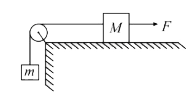The pulley arrangements in the figure (A) and (B) are identical. The mass of the rope is negligible. In figure (A), the mass m is lifted up by attaching a mass 2m to the other end of the rope. In figure (B), m is lifted up by pulling the other end of the rope with a constant downward force F = 2 mg . The acceleration of m is the same in both cases.

In figure (a), for the motion of mass m , T-mg=ma

For motion of mass 2m figure (b)
2 mg -T (2m)a …(2)
Adding equation (1) and (2) , we get
(b)In figure
But Therefore
Similar Questions
The pulley arrangements of Figs. (a) and (b) are identical. The mass of the rope is negligible. In (a) the mass m is lifted up by attaching a mass 2m to the other end of the rope. In (b), m is lifted up by pulling the other end of the rope with a constant downward force F=2mg. The acceleration of m is the same in both cases

View SolutionThe pulley arrangement in Fig are identical .The mass of the rope is negligble in figure the mass m is lifted up by atteched a mass 2m to the other end of the rope . In (b), m is lifed up by pulley the other end of the rope with a constant in both cases

View SolutionThe pulley arrangements shown in figure are identical, the mass of the rope being negligible. In case I the mass m is lifted by attaching a mass 2m to the other end of rope with a constant downward force F=2mg, where g is acceleration due to gravity The acceleration of mass m in case I is
 .
.
View SolutionFigure shown two pulley arrangments for lifting a mass m . In case-1, the mass is lifting by attaching a mass 2m while in case-2 the mass is lifted by pulling the other end with a downward force F=2mg . If aa and ab are the accelerations of the two masses then (Assumme string is massless and pulley is ideal).

View SolutionA man of mass m stands on a frame of mass M. He pulls on a light rope, which passes over a pulley. The other end of the rope is attached to the frame. For the system to be in equilibrium, what force must the man exert on the rope?

View SolutionA can of paint with a mass of 6 kg hangs from a rope. If the can is to be pulled up to a rooftop with an acceleration of 1m/s, what must be the tension in the rope ?
View SolutionFigure a) shows a spring of force constant k clamped rigidly at once end and a mass m attached to its free end. A force F applied at the free end stretches the spring. Figure b) shows the same spring with both ends free and attached to a mass m at either end. Each end of the spring in figure is stretched by the same force F.
(a) What is the maximum extension of the spring in the two cases ?
(b) If the mass in figure and the two masses in figure are released free, what is the period of oscillation in each case?

View SolutionFigure a) shows a spring of force constant k clamped rigidly at once end and a mass m attached to its free end. A force F applied at the free end stretches the spring. Figure b) shows the same spring with both ends free and attached to a mass m at either end. Each end of the spring in figure is stretched by the same force F.
(a) What is the maximum extension of the spring in the two cases ?
(b) If the mass in figure and the two masses in figure are released free, what is the period of oscillation in each case?

View SolutionIn the figure shown, all surfaces are smooth and the pulley is massless. A constant force of magnitude F=mg2 is acting on the block of mass M. The acceleration of the block M is :

View SolutionWhat is the mechanical advantage of single fixed pulley:-

View Solution
